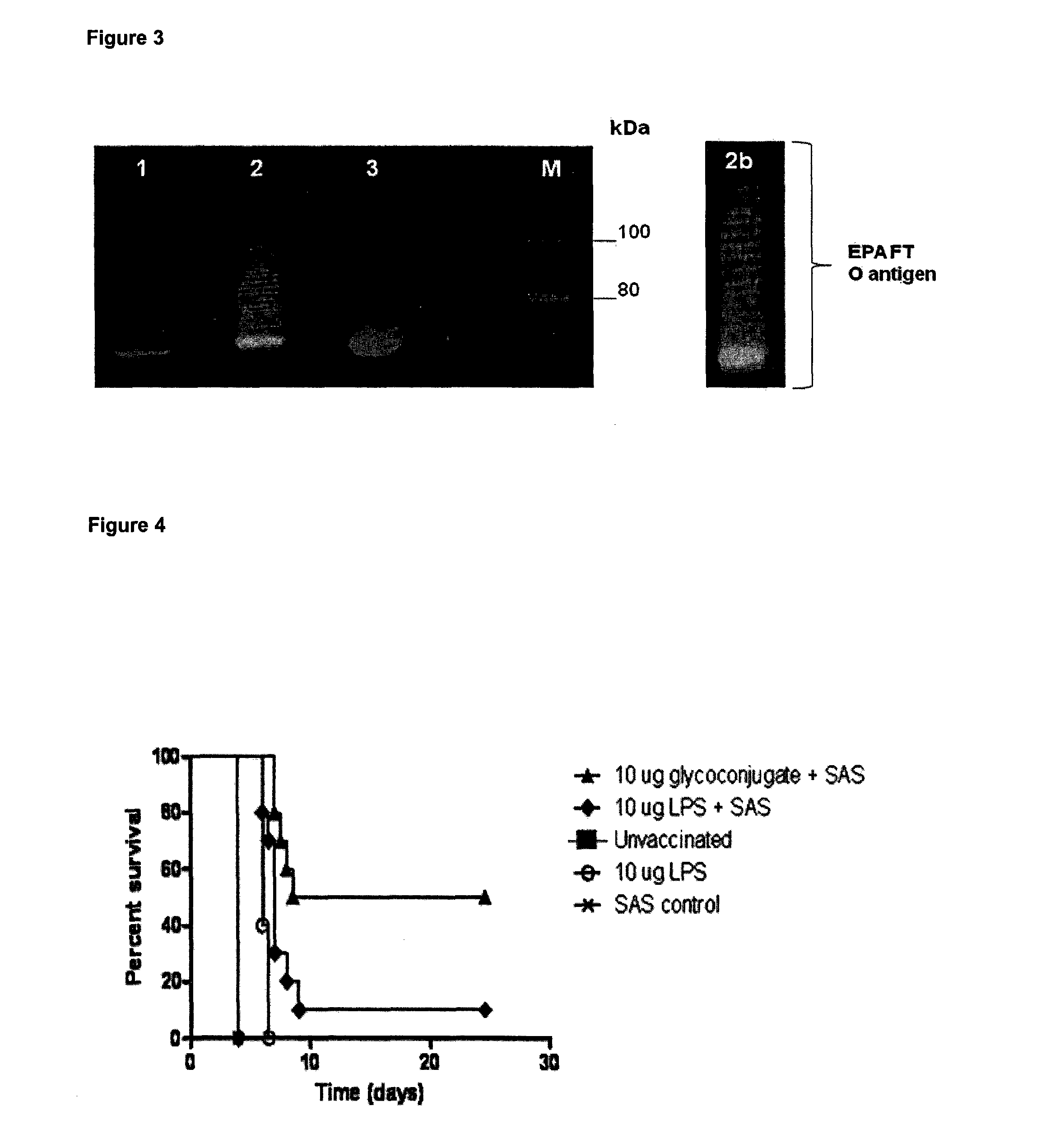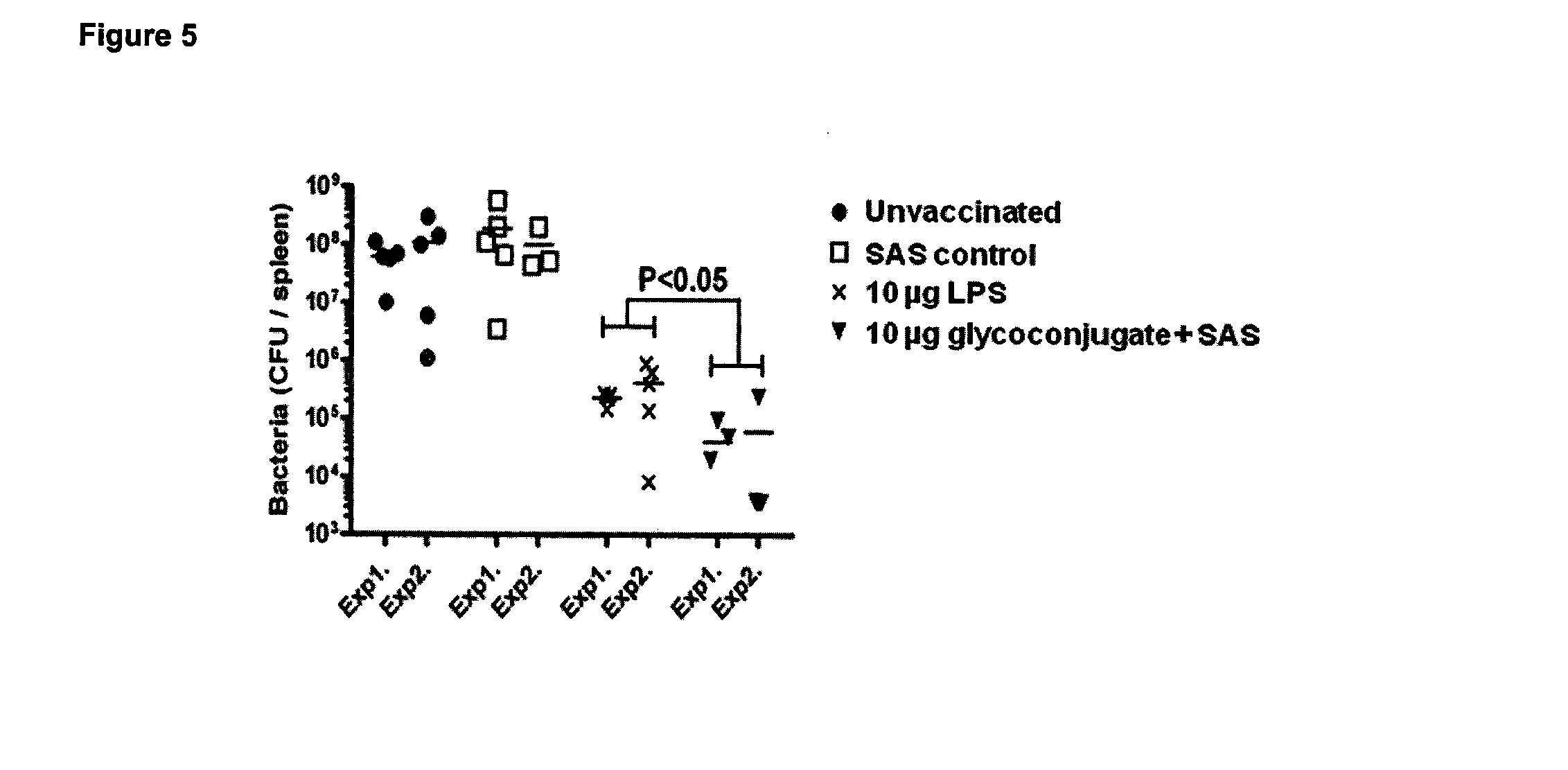Glycoconjugate vaccines
a technology of glycoconjugate and vaccine, applied in the field of glycoconjugate vaccine, can solve the problems of short half-life of antibodies, low affinity for specific antigens, impure products, etc., and achieve the effect of maintaining the stability of plasmids
- Summary
- Abstract
- Description
- Claims
- Application Information
AI Technical Summary
Benefits of technology
Problems solved by technology
Method used
Image
Examples
example 2
CjPgIB can Transfer F. tularensis O-Antigen to the Acceptor Protein Exotoxin A
[0133]In order to generate a strong T-cell response and lasting immunity, a highly immunogenic protein is required as a carrier for the F. tularensis O-antigen. The selected carrier protein was an inactivated form of the P. aeruginosa Exotoxin A variant L552V, ΔE553 (ExoA) was selected [20]. The plasmid pGAB2 containing the F. tularensis O-antigen expressed in the low copy vector pLAFR1 [21] was transformed into E. coli CLM24 cells along with the plasmids pGVXN114 and pGVXN150 which contain CjPgIB and ExoA respectively. As negative glycosylation controls, CLM24 cells were transformed with either pGVXN150 alone or with the combination of pGAB2, pGVXN150 and pGVXN115, the latter coding for an inactive version of CjPgIB [18]. Following overnight induction of CjpgIB and exoA expression with 1 mM IPTG and 0.2% L-arabinose (w / v) respectively, cells were lysed and HIS tagged ExoA purified using Nickel columns. El...
example 3
Vaccination with the Glycoconjugate Provides Significant Protection Against F. tularensis Subsp. Holarctica Infection in Mice
[0134]Ina pilot study we compared LPS alone against the glycoconjugate vaccine and monitored antibody levels and murine survival. The Sigma Adjuvant System® was selected for use in this study because it is based on monophosphoryl lipid A (MPL), a low toxicity derivative of LPS that has been demonstrated to be a safe and effective immunostimulant [22]. In order to demonstrate the specificity of the glycoconjugate we used controls including mice with SAS adjuvant alone, unvaccinated mice and mice vaccinated with a ‘sham’ glycoconjugate control (C. jejuni heptasaccharide conjugated to ExoA). Only mice vaccinated with 0.5 μg test glycoconjugate+SAS (P0.05) (FIG. 4). This experiment also indicated that LPS+SAS did not elicit the same level of protection as the glycoconjugate+SAS combination (P<0.05) and thereafter LPS+SAS was deemed unnecessary for testing. The stu...
example 4
Mice Vaccinated with Test Glycoconjugate and Challenged with F. tularensis Subsp. Holarctica have Lower Bacterial Loads and Pro-Inflammatory Cytokines 3 Days Post Challenge
[0135]Three days post challenge 5 mice per group were sacrificed and bacterial loads in the spleens and inflammatory responses were evaluated (FIG. 5). FIG. 5 shows the bacterial loads from vaccine with 10 μg of each candidate. Mice that were immunised with the glycoconjugate+SAS or LPS both had significantly decreased bacterial loads in spleens (P0.05).
PUM
| Property | Measurement | Unit |
|---|---|---|
| temperatures | aaaaa | aaaaa |
| temperatures | aaaaa | aaaaa |
| temperatures | aaaaa | aaaaa |
Abstract
Description
Claims
Application Information
 Login to View More
Login to View More - R&D
- Intellectual Property
- Life Sciences
- Materials
- Tech Scout
- Unparalleled Data Quality
- Higher Quality Content
- 60% Fewer Hallucinations
Browse by: Latest US Patents, China's latest patents, Technical Efficacy Thesaurus, Application Domain, Technology Topic, Popular Technical Reports.
© 2025 PatSnap. All rights reserved.Legal|Privacy policy|Modern Slavery Act Transparency Statement|Sitemap|About US| Contact US: help@patsnap.com



